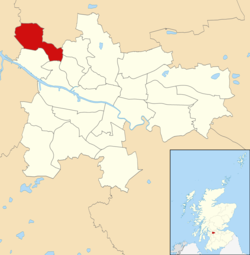Drumchapel/Anniesland
| |
|---|---|
 Drumchapel/Anniesland Ward (2017) within Glasgow | |
 View looking north-west over Drumchapel from Linkwood towers (2014) | |
| Area | 7.30 km2 (2.82 sq mi) |
| Population | 29,432 (2015) [1] |
| • Density | 4,031.8/km2 (10,442/sq mi) |
| Council area | |
| Lieutenancy area |
|
| Country | Scotland |
| Sovereign state | United Kingdom |
| Post town | GLASGOW |
| Postcode district | G13, G15 |
| Dialling code | 0141 |
| Police | Scotland |
| Fire | Scottish |
| Ambulance | Scottish |
Drumchapel/Anniesland (Ward 14) is one of the 23 wards of Glasgow City Council. [2] Since its creation in 2007 it has retained the same boundaries and returned four council members, using the single transferable vote system. [3]